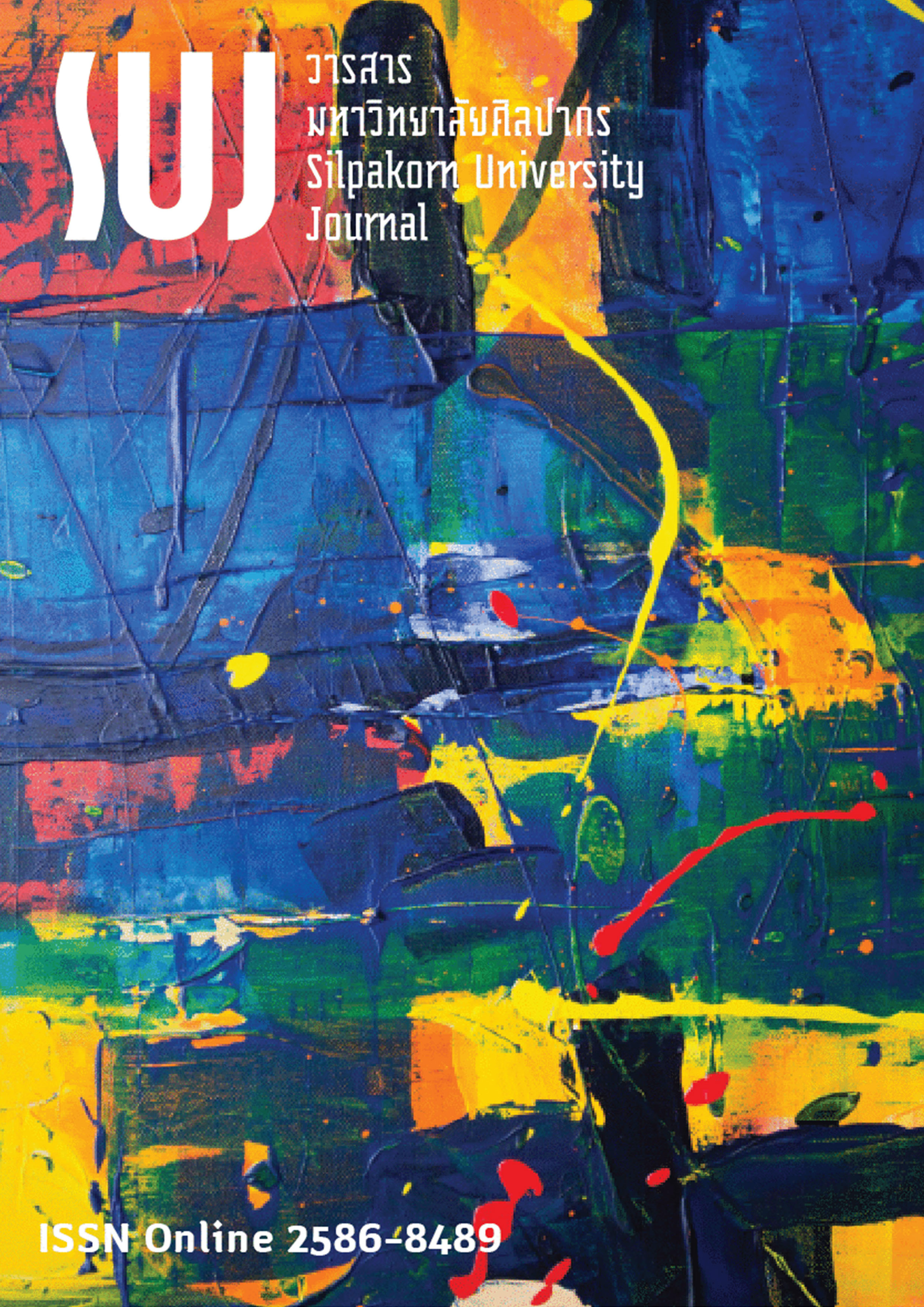การศึกษาหลักการและกลวิธีการสอนตัวอักษรจีนสำหรับผู้เรียนชาวไทย (Research on the principles and teaching strategies of the Chinese characters for Thai students)
Main Article Content
Abstract
ตัวอักษรจีนเป็นองค์ประกอบสำคัญของภาษาจีน ในกระบวนการการจัดการเรียนการสอนภาษาจีนจำเป็นต้องให้ความสำคัญกับการจัดการเรียนการสอนตัวอักษรจีน ปัจจุบันประเทศไทยมีผู้เรียนภาษาจีนเป็นจำนวนมากขึ้น แต่ความรู้ที่เกี่ยวกับตัวอักษรจีนยังคงเป็นปัญหาและอุปสรรคสำหรับผู้เรียนชาวไทย บทความนี้มุ่งเน้นในการศึกษาผ่านหลักการและกฎเกณฑ์ของตัวอักษรจีน ค้นหากลวิธีที่สามารถนำมาประยุกต์ใช้ในการสอนตัวอักษรจีนสำหรับผู้เรียนชาวไทย เพื่อเป็นแนวทางพัฒนาการจัดการด้านการเรียนการสอนภาษาจีนในประเทศไทยให้มีประสิทธิภาพมากขึ้น ผลการวิจัยพบว่า หลักการและกลวิธีการสอนตัวอักษรจีนสำหรับผู้เรียนชาวไทย ได้แก่ 1. การตั้งวัตถุประสงค์และข้อกำหนดของการเรียน 2. การกำหนดขอบเขตของตัวอักษรจีนที่จะศึกษาและต้องมีความรู้เกี่ยวกับโครงสร้างและความหมายของตัวอักษรจีน 3. การลำดับความยากง่าย โดยเริ่มเรียนรู้จากสิ่งที่ง่ายก่อนแล้วเข้าสู่สิ่งที่ยากขึ้น 4. การลงในรายละเอียดของการศึกษาตัวอักษรจีน เช่น โครงสร้างของตัวอักษรจีน ตำแหน่งของส่วนประกอบในตัวอักษรจีน และการเปรียบเทียบส่วนประกอบอักษรจีนที่คล้ายกัน
Chinese characters are a key element of Chinese language. In the process of teaching and learning Chinese, it is necessary to focus on teaching and learning Chinese characters. Nowadays, there are more and more people in Thailand learning Chinese, but Chinese characters are still a problem and obstacle for Thai learners. This article explores the principles and rules of Chinese characters and research strategies that could be applied in the practice of teaching Chinese characters, and this will lead to the development of teaching and learning Chinese in Thailand. The results suggested that the principles and strategies of Chinese character teaching for Thai learners should comprise these steps: 1) setting goals and learning requirements; 2) clarifying the learning scope of Chinese characters and understand the structure and meaning of Chinese characters; 3) setting the level of the characters’ difficulty by starting from the easiest level to the most difficult level; and 4) in terms of the content, having students study the details of Chinese characters in depth, such as looking at the structure of Chinese characters, the position of the component in Chinese characters, and comparing the similar Chinese Radicals.
Downloads
Article Details

This work is licensed under a Creative Commons Attribution-NonCommercial-NoDerivatives 4.0 International License.
References
Cui, Y. (1998). A Thought on Teaching Chinese Characters (关于汉字教学的一种思路). Journal of Peking University (北京大学学报), 35(3): 114-118.
Dai, X. (2014). Investigation of Difficulties and Teaching Strategies in Teaching Chinese Characters as a Foreign Language (论对外汉语汉字教学难点及其教学策略). Master’s dissertation, Anhui University, Hefei, China PR.
Du, L. (2019). Research on Teaching Strategies of Chinese Characters as a Foreign Language (汉字的对外汉语教学策略研究). The Science Education Article Collects (科教文汇), 462: 62-65.
Gong, Y. (2008). Investigation and Reflection on the Current Situation of Chinese Teaching in Kanchanapisek Wittayalai Nakhon Pathom Schools (佛统甘乍那披色中学汉语教学现状调查及思考). Master’s dissertation, Zhengzhou University, Henan, China PR.
Huang, B., & Liao, X. (2007). Modern Chinese Language (现代汉语) (4th ed.). BeiJing: Higher Education Press.
Liu, A. (2019). Chinese Characters Teaching Based on Cognitive Psychology — Take the Confucius Institute at the Confucius Institute at the Catholic University of Santa Maria in Peru as an Example (基于认知心理学的汉字教学——以秘鲁圣玛利亚天主教大学孔子学院为例). Master’s dissertation, Guangdong University of Foreign Studies, Guangdong, China PR.
Lyu, B. (1999). Chinese Characters Teaching and Chinese Language Teaching (汉字教学与汉语教学). In The Essay Collection on Chinese Characters and Chinese Characters Teaching Research (汉字与汉字教学研究论文选), (pp.13-29). Beijing: Peking University Press.
Office of Chinese Language Council International. (2007). Standards for international Chinese Teachers (国际汉语教师标准). Beijing: Foreign Language Teaching and Research Press.
Office of Teaching Chinese as a Foreign Language. (2002). Chinese Syllabus for Foreign Students in Colleges and Universities (高等学校外国留学生汉语教学大纲). Beijing: Beijing Language and Culture University Press.
Sun, F., & Zhang, Jing. (2021). Discussion on Chinese Character Teaching Strategy in Teaching Chinese as a Foreign Language (对外汉语教学中汉字教学策略探讨). Sinogram Culture (汉字文化), 280: 106-107.
Theeravit, Khien et al. (2551). Teaching the Chinese Language in Thailand at the Higher Education Level: Research Report No. 3 (การเรียนการสอนภาษาจีนในประเทศไทยระดับอุดมศึกษา: รายงานวิจัย ฉบับที่ 3). Bangkok: Chinese Studies Center, Institute of Asian Studies, Chulalongkorn University.
Wasinanon, Naris, & Wasinanon, Sukanya. (2019). The Study of the Problems in Chinese Character Writing Errors Made by the Freshmen of Huachiew Chalermprakiet University (การศึกษาปัญหาการเขียนอักษรจีนผิดที่พบบ่อยของนักศึกษาชั้นปีที่ 1 มหาวิทยาลัยหัวเฉียวเฉลิมพระเกียรติ). Ramkhamhaeng University Journal Humanities Edition, 38(1): 85-100.
Zhang, X. (1997). The Teaching Method of Basic Characters with Characters Applied to Foreigners’ Chinese Character Learning (基本字带字教学法应用于外国人汉字学习). Sinogram Culture (汉字文化), (4): 47-52.
Zhang, Y. (1999). Chinese Characters Association Network and Teaching Chinese Characters to Foreigners (汉字联想网及对外汉字教学). In The Essay Collection on Chinese Characters and Chinese Characters Teaching Research (汉字与汉字教学研究论文选). (pp.257-264). BeiJing: Peking University Press.
Zhang, Z. (2013). An analysis of Chinese Characters Teaching in Chinese as a Foreign Language (浅谈对外汉语中的汉字教学). The Guide of Science & Education (世界汉语教学), 9(19): 72.
Zhao, Jin. (2019). Introduction to Teaching Chinese as a Foreign Language (对外汉语教学概论). Beijing: The Commercial Press.


